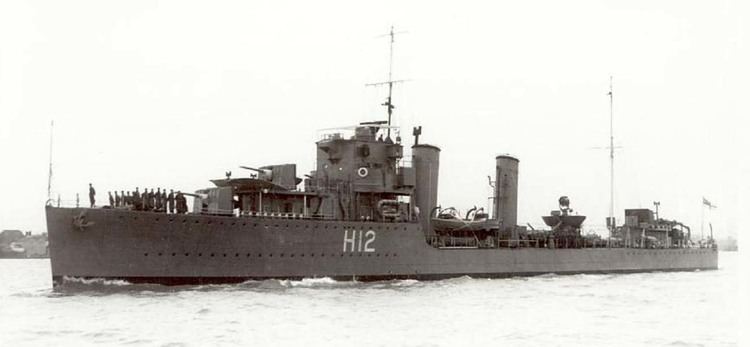Name HMS Achates Yard number 526 Commissioned 27 March 1930 Launched 4 October 1929 Draft 3.73 m | Ordered 6 March 1928 Laid down 11 September 1928 Construction started 11 September 1928 Length 98 m Builder John Brown & Company | |
 | ||
Motto Fidus Achates (Latin "Faithful Achates") | ||
HMS Achates was an A-class destroyer of the British Royal Navy launched on 4 October 1929 and commissioned on 27 March 1930. She was sunk on 31 December 1942 in the Battle of the Barents Sea.
Contents
Battle of the Denmark Strait
In early May 1941, the British Admiralty was on the alert that the German battleship Bismarck might attempt to break out into the North Atlantic, so Achates was ordered to Scapa Flow for possible deployment against the Germans. On 22 May, just after midnight, Achates sailed along with the destroyers Electra, Antelope, Anthony, Echo, and Icarus, escorting the battlecruiser Hood and the battleship Prince of Wales to cover the northern approaches. The intention was that the force would refuel in Hvalfjord, Iceland, and then sail again to watch the Denmark Strait.
On the evening of 23 May, weather started getting bad. At 2055 hrs., Admiral Lancelot Holland aboard Hood signaled the destroyers "If you are unable to maintain this speed I will have to go on without you. You should follow at your best speed." At 0215 on the morning of 24 May, the destroyers were ordered to spread out at 15 mi (24 km) intervals to search to the north. At about 0535, the German forces were sighted by Hood, and shortly after, the Germans sighted the British ships. Firing commenced at 0552. At 0601, Hood suffered a massive explosion, sinking the ship within two minutes.
Electra and the other destroyers were about 60 mi (97 km) away at the time. Upon hearing that Hood had sunk, Electra raced to the area, arriving about two hours after Hood went under. They were expecting to find many survivors, and rigged scrambling nets and heaving lines, and placed life belts on the deck where they could be quickly thrown in. From the 94 officers and 1,321 enlisted men who were aboard Hood, only three survivors were found. Electra rescued these survivors, and continued searching. Shortly thereafter, Icarus and Anthony joined in and the three ships searched the area for more survivors. No more were found, only driftwood, debris, and a desk drawer filled with documents. After several hours searching, they left the area.
Kirkenes and Torch
In July 1941, while taking position in the screen of carriers preparing for the air strike against Kirkenes/Petsamo, Achates was mined and severely damaged, but managed to make port for repairs.
On 8 November 1942, while deployed off Oran, Algeria for operation "Torch", Achates detected, and attacked the Vichy French submarine Argonaute, which had sortied to contest the Allied landings in the area. Achates attack on Argonaute, saw the rise of oil to the surface of the sea and huge air bubbles, as well as debris from both inside, and outside the submarine. Following this, at a later point, HMS Westcott made a further attack, hence both ships were credited with her demise.
Battle of the Barents Sea
On 31 December 1942, Achates was on escort duty protecting the convoy JW 51B en route from Loch Ewe to Murmansk when she was sunk in the Barents Sea
The German heavy cruiser Admiral Hipper, pocket battleship Lützow and six large destroyers had been ordered to attack and destroy the convoy. Despite being heavily outgunned the escort, under the command of Captain R. St. Vincent Sherbrooke, beat off the attack and not one merchant vessel was lost.
At 11:15, Achates was laying smoke to protect the convoy when she was hit by gunfire from Admiral Hipper, killing the commanding officer, Lt Cdr Johns, and forty crew. The First Lieutenant, Lt L. E. Peyton-Jones, took over command and, despite having sustained severe damage in the shelling, Achates continued her smoke screen operation. At 13:30 she went down 135 nautical miles (250 km; 155 mi) ESE of Bear Island. 113 seamen were lost and 81 were rescued, one of whom later died on the trawler Northern Gem which had come to the aid of Achates. In response, the light cruiser Sheffield damaged Admiral Hipper, and subsequently sank her escort, Z16 Friedrich Eckoldt.
Awards
Following the battle, the following awards for gallantry were made to men on Achates:
D.S.O.: Lt L. E. Peyton-Jones D.S.C. Posthumously awarded to Lt Cdr A. H. T. Johns
Conspicuous Gallantry Medal: ERA H. Hawksworth.
D.S.C.: Gunner (T) G. W. D. Smith
D.S.M.: Stoker J. Colley; Able Seaman C. Brightmore; Able Seaman H. Platt; CPO D. Hall; Stoker E. Drummond; Stoker L. Meacock; Yeoman of Signals A. W. Taylor.
Mentioned in Despatches: Chief Stoker W. Brown, D.S.M.; Leading Seaman R. C. Wells; PO F. Batchelor; Telegraphist E. J. Dickinson; Stoker W. Wilkinson.
Posthumously Mentioned in Despatches: Lt (E) P. A. Wright, R.N.R.; Surgeon-Lt J. L. MacFarlane; Stoker PO R. Bell; Supply PO R. Bell; Supply PO J. R. Cole; Able Seaman K. MacIver; Able Seaman C. W. Coe; PO Telegraphist W. Bartripp; Officers Steward A. Jones; Canteen Manager G. Drummond; PO B.C. Carpenter.
Seaman Kenneth MacIver RNR was posthumously mentioned in despatches. He put himself at risk to rescue comrades in a rapidly flooding cabin, then made trips across the deck while under heavy fire to take over the ships wheel. With the aid of just a ships compass he continued to steer the stricken ship and maintain the laying down of smoke screen. Unfortunately, as the survivors were being picked up the wheelhouse was totally destroyed by further shelling and Seaman MacIver lost his life.
